Valley of Flowers (2025): Trek with TourMyHoliday - Easy Guide
Published on July 09, 2025
Valley of flowers tour package, Get ready for an amazing adventure! The Valley of Flowers in 2025 is waiting for you, and TourMyHoliday makes it super easy to visit this special place. Imagine a whole valley covered in colorful flowers, hidden high in the Himalayas. It's a UNESCO World Heritage site, meaning it's super important and beautiful!
What's the Valley of Flowers All About?
This beautiful valley, nestled in Uttarakhand, India, is like a natural garden that changes colors every few weeks as different flowers bloom. It's home to hundreds of types of alpine flowers, some found nowhere else! You might even spot some rare animals if you're lucky. The valley typically opens from June 1st and stays open through September, with July and August being the best time to see the most flowers.

Unfold Your Valley of Flowers Journey: A Day-by-Day Plan with TourMyHoliday
Day 1: Arrival in Rishikesh & Drive to Govindghat / Pipalkoti
- Arrive at Rishikesh , the yoga capital of the world, known for its serene vibes and spiritual energy.
- After breakfast, meet your tour representative at The 60s Cafe (The Beatles Café) — a nostalgic start point of your Himalayan journey.
- Begin your scenic drive towards Govindghat / Pipalkoti (approx. 280 km, 8–9 hours), passing through charming hill towns like Vikasnagar, Chinyalisaur, and Joshimath .
- En route, enjoy breathtaking views of snow-capped peaks, deep gorges, and flowing rivers like the Alaknanda and Pindar .
- On reaching Govindghat, check into your pre-booked accommodation.
- Rest and relax for the night, preparing for the trekking days ahead.
Overnight Stay: Govindghat / Pipalkoti
Day 2: Trek from Govindghat / Pipalkoti to Ghangaria (14 km / 7–8 hrs)
- Post an early breakfast, begin your ascent towards Ghangaria , a key base camp for trekkers heading to both the Valley of Flowers and Hemkund Sahib .
- The trail follows the Bhyundar Valley , winding through dense forests of rhododendron and oak, alongside the roaring Pushpawati River .
- Cross several small wooden bridges and witness cascading waterfalls and natural hot springs along the way.
- Reach Ghangaria , a quaint mountain village nestled between two glacial streams, and check into your guesthouse or dormitory.
- Spend the evening exploring the surroundings or relaxing in this tranquil setting.
Overnight Stay: Ghangaria
Day 3: Full-Day Exploration of Valley of Flowers
- Rise early and head out for the much-awaited visit to the Valley of Flowers , located about 3 km from Ghangaria.
- As you enter this UNESCO World Heritage Site, be mesmerized by a vibrant carpet of wildflowers in every shade imaginable — from dazzling reds and purples to soft pinks and yellows.
- Walk through the valley, soaking in the fragrance of alpine flora, and capturing stunning photographs of rare blossoms and butterflies fluttering around.
- Visit the Pushpavati River and enjoy a peaceful sit-down amidst nature.
- Return to Ghangaria in the afternoon for some rest.
- Optional: Visit the nearby Sindhu Ghati Park , another floral attraction slightly off the main trail.
Overnight Stay: Ghangaria
Day 4: Trek to Hemkund Sahib & Back to Ghangaria
- Wake up early and set off for the holy Sri Hemkund Sahib Gurudwara , situated at an altitude of 4,329 meters.
- The trek is steep and moderately challenging (approx. 6 km one-way), passing through rocky terrain and pine forests.
- Upon reaching the gurudwara, experience the spiritual serenity and marvel at the pristine glacial lake beside it.
- Spend time in prayer or simply absorbing the majestic views of surrounding peaks like Mount Nanda Devi .
- Descend back to Ghangaria in the afternoon, where you can unwind and prepare for the return journey.
Overnight Stay: Ghangaria
Day 5: Descent Trek from Ghangaria to Govindghat / Pipalkoti
- Today marks the end of your trekking days. Start your descent back to Govindghat / Pipalkoti .
- The downhill trek (approx. 14 km) is relatively easier and allows you to enjoy the panoramic views without the effort of climbing uphill.
- Take breaks at scenic spots, reflect on your Himalayan journey, and click last-minute pictures.
- On reaching Govindghat, board your waiting vehicle for a relaxing drive back to Rishikesh .
- Overnight halt en route or continue driving depending on time and road conditions.
Overnight Stay: On the way or reach Rishikesh late night (depends on traffic)
Day 6: Transfer to Rishikesh & Departure
- After a refreshing night’s sleep, proceed towards Rishikesh , concluding your soul-stirring Himalayan adventure.
- On arrival in Rishikesh, you may choose to explore local attractions like Lakshman Jhula , Triveni Ghat , or enjoy a peaceful session of meditation or yoga.
- Later, transfer to your onward destination — whether it’s the airport, railway station, or bus stand.
End of Tour
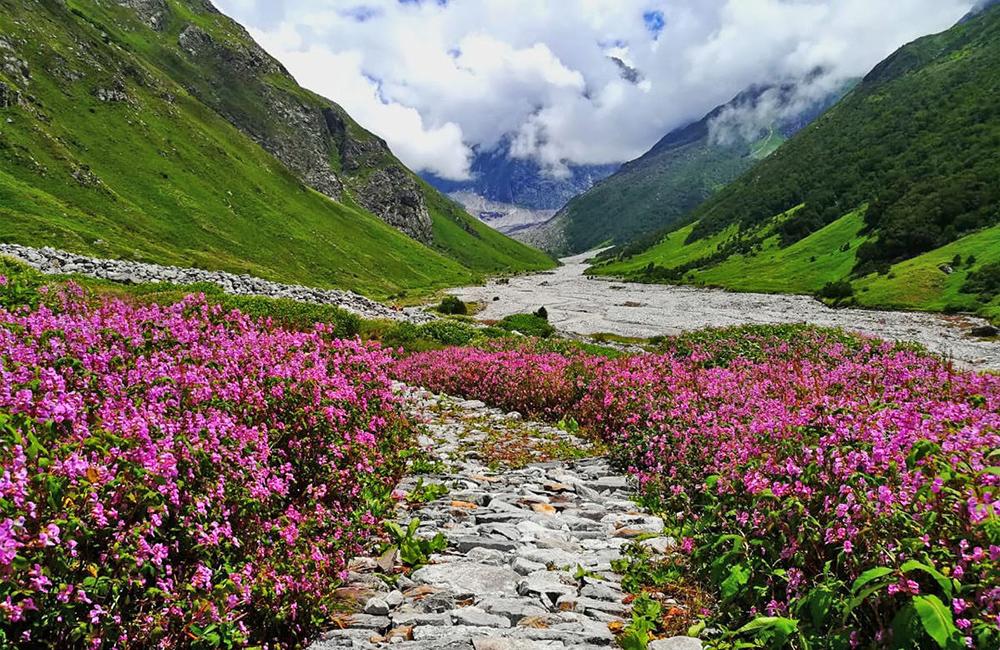
Your Easy Trek with TourMyHoliday:
The journey to the Valley of Flowers involves a lovely trek. It's not too hard, but you'll need to be fit enough for walking. TourMyHoliday helps you every step of the way!
Your Valley of Flowers Tour Package:
We make your trip simple and stress-free. Our Valley of Flowers Tour Packages include everything you need for a comfortable and memorable journey. Forget about planning every detail – we've got it covered!
Getting There with Ease:
No matter where you're coming from, TourMyHoliday has a Valley of Flowers tour package from Delhi, Valley of Flowers tour package from Rishikesh, Valley of flowers tour package from Mumbai, and even a Valley of Flowers package from Haridwar. We arrange all your travel, so you just relax and enjoy the views as you head towards Govindghat, the starting point of your trek.
Perfect for Everyone:
Whether you're a couple looking for a romantic escape with our Valley of flowers tour package for couple, or a group of friends and family, we have options for you. Our Valley of Flowers trek packages are designed for different levels of fitness, so everyone can enjoy the beauty of the Himalayas.
Why Choose a Guided Tour?
With our Valley of Flowers guided tours, you'll have experienced local guides who know the valley inside out. They'll show you the best spots, tell you about the different flowers, and make sure your trek is safe and fun. You don't have to worry about permits, routes, or anything – just focus on the incredible scenery!
Fixed Departures for Easy Planning:
Looking for a set travel date? Our Valley of Flowers fixed departures are pre-planned trips on specific dates. This is perfect if you want to join a group and share the experience with other travelers. It's a convenient way to book your adventure without any hassle.
What to Expect on Your TourMyHoliday Trip:
-
Comfortable Stays: We arrange your accommodation in clean and cozy guesthouses or hotels, mostly in Ghangaria, the base camp for the valley.
-
Delicious Meals: Enjoy tasty, wholesome meals throughout your trip.
-
Expert Guides: Our friendly guides will lead you through the stunning trails, sharing their knowledge of the local flora and fauna.
-
Hassle-Free Travel: We take care of transport from your starting point to Govindghat, making your journey smooth.
-
Safety First: Your safety is our priority. Our guides are trained and knowledgeable about the mountain environment.
What's Included :
-
Comfy Stays: Cozy rooms or tents for a good night's rest.
-
Tasty Meals: Delicious vegetarian food to keep you energized on your trek.
-
Friendly Guides: Expert local guides to lead your way and share amazing facts.
-
Easy Travel: All your main transport to and from the trek start point.
-
Entry & Permits: We handle all the necessary permissions for the Valley of Flowers.
-
Safety Gear: Basic first-aid and safety support for your peace of mind.
-
Memories: A trip packed with stunning views and unforgettable moments!
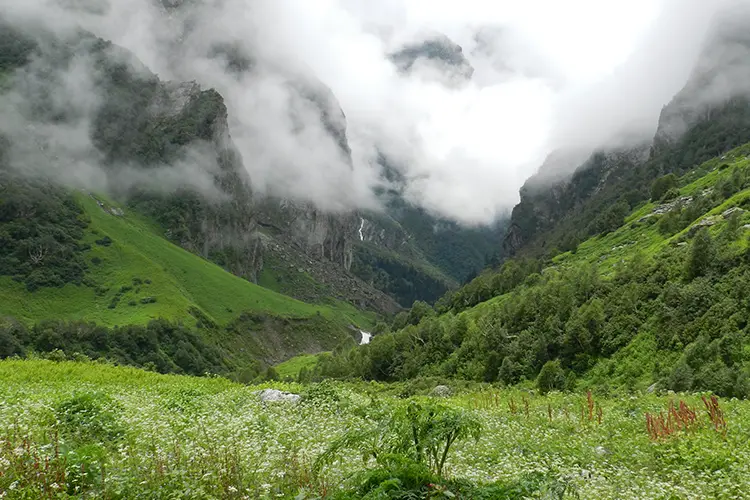
Best Time to Visit the Valley of Flowers: When to See the Magic!
Wondering when's the perfect time to visit the Valley of Flowers? Well, the valley has its own calendar, and it's all about when the flowers are in full bloom! The Valley of Flowers National Park typically opens on June 1st each year and closes by September end/early October, depending on the weather. Here’s a simple guide to help you pick your ideal time:
Early June: The Green Awakening & Snow Patches
-
What to expect: When the valley first opens, it's very green and fresh from the winter snow. You'll still see patches of snow, especially in higher areas. The number of flowers will be less compared to later months.
-
Why visit: If you love crisp mountain air, a quieter trek, and seeing the valley emerge from winter, early June is good. Waterfalls will be gushing with melted snow!
-
Flowers: You'll see some early bloomers, but the grand display hasn't begun yet.
Mid-June to Early July: The First Burst of Color
-
What to expect: As the snow melts further, more flowers begin to pop up. The valley starts transforming into a vibrant carpet. The monsoon rains usually begin by mid-July.
-
Why visit: This is a great time to avoid the peak crowds of August, while still enjoying a good variety of flowers. The weather is generally pleasant before the heavy rains start.
-
Flowers: Many varieties will be in bloom, and the valley starts looking truly spectacular.
Mid-July to Mid-August: Peak Bloom – The Valley at its Best!
-
What to expect: This is hands-down the Best time to visit if you want to see the maximum number of flowers. The monsoon rains are usually active, which makes the flowers bloom beautifully and keeps the valley lush green. Expect rain, fog, and sometimes muddy trails.
-
Why visit: This is when the Valley of Flowers lives up to its name! It's an explosion of colors – reds, yellows, blues, purples, and whites. Photographers and flower lovers will be in heaven.
-
Flowers: You'll see the widest variety and densest carpet of flowers. This is the prime time for viewing.
Late August to Mid-September: Still Beautiful, Fewer Crowds
-
What to expect: While the peak bloom might be over, the valley is still stunning. The rains start to lessen, and the weather can be clearer. Some flowers might be fading, but others will still be vibrant.
-
Why visit: If you prefer fewer crowds and clearer views, this is a good time. The valley retains its charm, and the autumn colors might start to appear in the surrounding mountains later in September.
-
Flowers: Still a good variety, but the massive, dense carpet might start to thin out in some areas.
Late September to Early October: Preparing for Winter
-
What to expect: The valley is preparing to close for winter. The flowers are mostly gone, and the landscape turns golden and brown. Snowfall can begin in higher reaches.
-
Why visit: Only recommended if you want to see the autumn colors of the mountains and don't mind not seeing many flowers. The park closes around this time.
Our Recommendation for TourMyHoliday Travelers: For the most breathtaking floral display, we highly recommend visiting between mid-July and mid-August. Just be prepared for rain and pack accordingly!
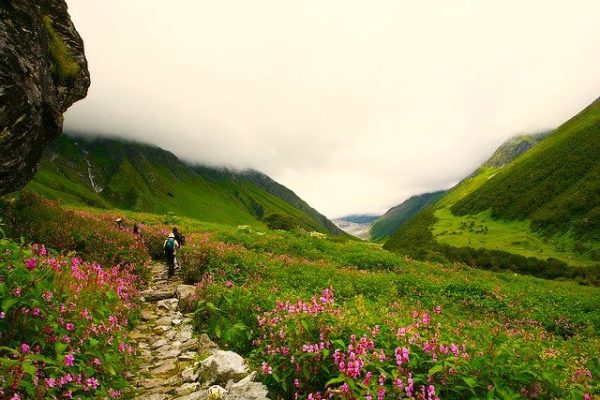
What to Pack for Your Valley of Flowers Adventure: Your TourMyHoliday Checklist!
Getting ready for your Valley of Flowers trek with TourMyHoliday is exciting! But what exactly should you bring? The weather in the mountains can change quickly, especially during the blooming season (July and August), so smart packing is key. Don't worry, we've made a simple list to help you pack light but smart.
The Golden Rule: Layers, Layers, Layers!
Instead of one heavy jacket, pack several thinner layers. This way, you can add or remove clothes as the temperature changes during your trek.
1. Clothes for Comfort & Weather:
-
Trekking Pants (2-3 pairs): Choose lightweight, quick-drying pants. Avoid jeans – they get heavy and uncomfortable when wet. Track pants or special trekking pants are perfect.
-
T-shirts (3-4): Quick-dry (polyester or synthetic) shirts are best. Cotton can take a long time to dry if it gets wet.
-
Warm Layers (2-3): Fleece jackets, wool sweaters, or light down jackets are great. You'll need these in the evenings and mornings, and for higher points like Hemkund Sahib or inside the Valley if it gets chilly.
-
Thermal Wear (1 set): A thermal top and bottom are wonderful for keeping warm, especially at night in Ghangaria.
-
Rain Gear (SUPER IMPORTANT!):
-
Waterproof Jacket / Raincoat: A good quality one is a must. Make sure it has a hood.
-
Rain Pants / Poncho: These will keep your lower body dry. A poncho is a simple, lightweight option that covers you and your backpack.
-
-
Socks (3-4 pairs): Mix of regular sports socks and a couple of warm, woolen socks for evenings. Wet feet are no fun!
-
Undergarments: Pack enough for your trip.
2. Shoes & Footwear (Your Best Friends!):
-
Trekking Shoes/Boots: This is the most important item!
-
Choose waterproof shoes with good ankle support and strong grip.
-
Make sure they are well-broken in (don't buy new ones just before the trip!). Blisters are a trekkers worst enemy.
-
They should be comfortable for long walks on uneven paths.
-
-
Sandals/Flip-flops: For relaxing at your guesthouse in the evenings. Give your feet a break from trekking shoes!
3. Essential Accessories:
-
Small Daypack (15-20 litres): This is for your daily treks to the Valley or Hemkund. Carry your water bottle, snacks, camera, and rain gear here. Your main luggage will be at the guesthouse or carried by porters.
-
Sun Hat/Cap: To protect you from the sun when it's out.
-
Woolen Cap/Beanie: For cold mornings and evenings.
-
Gloves (light wool or fleece): To keep your hands warm.
-
Sunglasses: Protect your eyes from bright sun and glare.
-
Trekking Pole(s): Highly recommended! They help with balance on tricky paths, reduce strain on your knees, and make uphill climbs easier.
-
Water Bottle: Carry at least a 1-liter reusable bottle. Staying hydrated is key!
-
Torch/Headlamp: Electricity can be unreliable, especially in remote areas. Don't forget extra batteries!
-
Small Towel: Quick-dry travel towels are best.
-
Personal Toiletries: Toothbrush, toothpaste, soap, shampoo, moisturizer, lip balm (lips can get dry). Keep them minimal and travel-sized.
-
Sunscreen (SPF 30+): The mountain sun is strong!
-
Hand Sanitizer: Useful when water isn't readily available.
-
Small First-Aid Kit:
-
Band-Aids for blisters (very common!)
-
Painkillers (for headaches, body aches)
-
Antiseptic cream
-
Any personal medications you regularly take
-
Muscle relaxant spray/gel
-
Crepe bandage (for sprains)
-
-
Power Bank/Portable Charger: Electricity access can be limited. Keep your phone and camera charged!
-
Camera with Extra Batteries: You'll want to capture those amazing flowers!
-
Plastic Bags/Ziplocks: For separating wet clothes, protecting electronics from rain, and carrying any trash out of the park.
-
Identity Proof: Carry your original ID and a photocopy for park permits and hotel check-ins.
Optional (but Nice to Have):
-
Energy Bars/Dry Fruits/Chocolates: Quick energy boosts on the trail.
-
Small Notebook & Pen: For journaling your experiences or noting flower names.
-
Earphones: For relaxing during travel.
What NOT to Bring:
-
Heavy Jeans: As mentioned, they're not good for trekking.
-
Valuable Jewelry: Best left at home.
-
Too Many Clothes: You'll only wear a few key items. Pack light to make your journey easier!
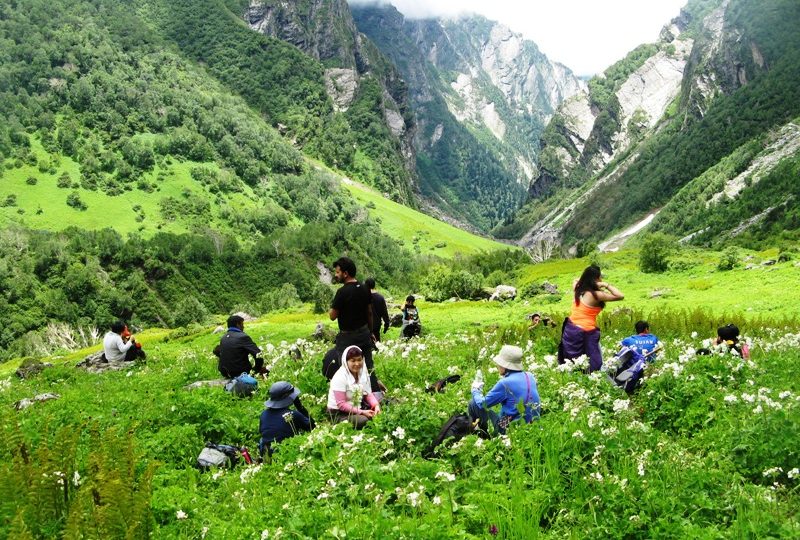
Your Valley of Flowers Budget: Making the Most of ₹9,500 with TourMyHoliday!
Planning your dream trip to the Valley of Flowers doesn't have to break the bank. At TourMyHoliday, we believe in making this amazing experience accessible. So, if you're looking at a budget around ₹9,500 for your Valley of Flowers adventure, here's what you can expect and how we help you get the best value!
The ₹9,500 Sweet Spot: What's Typically Included
A well-planned Valley of Flowers tour package in this range (often for 5-6 days, starting from places like Haridwar or Rishikesh) generally offers a fantastic base for your trek. With TourMyHoliday, a package around ₹9,500 usually covers the core essentials, taking away most of the planning stress:
-
Your Journey to the Base (Transport): This budget often includes comfortable group transport (like a Tempo Traveller or similar) from a major starting point like Haridwar or Rishikesh right up to Govindghat (the trek start point) and back. This means you don't have to worry about finding buses or taxis on your own.
-
Your Home in the Hills (Accommodation): Expect clean, basic, and comfortable stays in guesthouses or hotels, especially in Ghangaria (your base camp for the Valley). This is usually on a shared basis (e.g., triple or quad sharing), which keeps costs down while still giving you a cozy place to rest.
-
Fuel for Your Feet (Meals): Most packages at this price include all your meals during the trek days (typically from dinner on Day 1 to breakfast on the last day). These are usually simple, delicious, and energy-packed vegetarian meals that are perfect for trekking.
-
Your Mountain Guides: Experienced and friendly trek leaders and local guides are usually part of the package. They'll show you the way, share insights about the flowers, and ensure your safety. This is super important!
-
Park Permits: The entry fees and necessary permits for entering the Valley of Flowers National Park are often taken care of within this budget, saving you hassle at the entry gate.
-
Basic Safety: First-aid kits, and often even an oxygen cylinder for emergencies, are usually part of the safety measures provided.
Getting Maximum Value for Your ₹9,500 with TourMyHoliday:
We've designed our packages to give you the best possible experience within a sensible budget. Here's how this budget helps you focus on the magic:
-
Stress-Free Logistics: The biggest win with a package like this is that TourMyHoliday handles all the trickiest parts – arranging transport from your city (or nearby hub), booking stays in remote locations like Ghangaria, and managing permits. This saves you hours of planning and potential headaches.
-
Guided Expertise: Having a knowledgeable guide ensures you don't miss hidden gems and stay safe on the trails. This expertise is invaluable and included in your package.
-
Group Perks: When you book a Valley of Flowers tour package from Delhi, a Valley of Flowers tour package from Rishikesh, or a Valley of Flowers package from Haridwar with us, you often join a group. This not only makes the trip more affordable (group discounts!) but also means you travel with like-minded adventurers, often forming new friendships.
-
Focused on the Trek: With the main costs covered, you can focus purely on the breathtaking Valley of Flowers trek packages and the incredible scenery, rather than constantly thinking about expenses.
Understanding What's Not Always Included (and how to plan for it):
While ₹9,500 gets you a lot, it's good to be aware of a few extra costs you might encounter:
-
Personal Expenses: Things like snacks beyond meals, bottled water (though we encourage refilling!), personal shopping, or extra hot water bucket baths at guesthouses are usually extra.
-
Offloading Your Bag: If you don't want to carry your main backpack (only a small daypack is needed for daily treks), you can hire a porter or mule from Govindghat or Pulna to Ghangaria. This is an additional cost (typically a few hundred rupees per day).
-
Hemkund Sahib Visit: While our tours guide you on how to visit, the optional trek to Hemkund Sahib often has a separate porter/mule cost if you choose to use one for that steeper climb.
-
Travel to Major Hubs: Your package might start from Haridwar or Rishikesh. So, your travel costs to get to these starting points (e.g., train or bus ticket for a Valley of Flowers tour package from Mumbai) would be separate.
-
Unexpected Delays: In the mountains, landslides or bad weather can sometimes cause delays. While rare, any extra costs for an unscheduled overnight stay due to such events are usually not included. Always keep a small buffer budget for such possibilities.
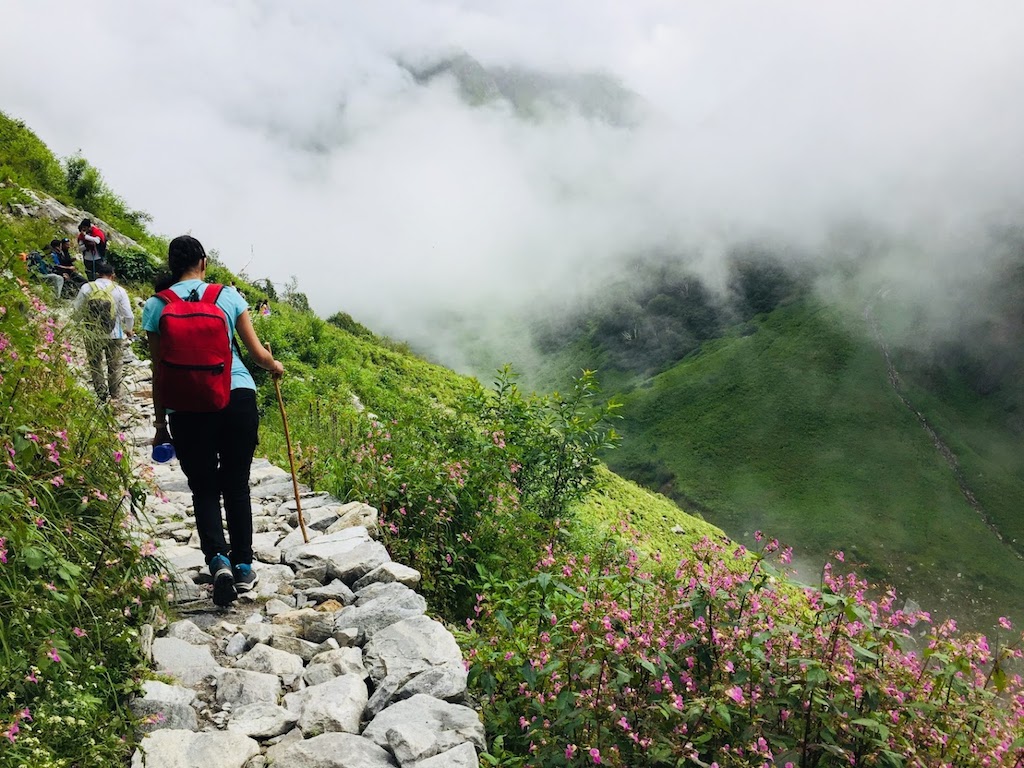
Your Cozy Nests on the Valley of Flowers Trail: TourMyHoliday Accommodation Guide
When you trek to the magical Valley of Flowers, where you rest your head each night is an important part of the adventure! While you won't find luxury resorts right inside the blooming valley itself, TourMyHoliday ensures you have comfortable and clean places to recharge before and after your magnificent floral explorations.
Here's a simple breakdown of your "homes away from home" on this special journey:
1. Gateway Town Comfort: Joshimath or Govindghat
Your journey often begins with a night's stay in a town like Joshimath or Govindghat. These are the last motorable points before you begin your trek to Ghangaria.
-
What to expect: Here, you'll find a range of hotels and guesthouses. TourMyHoliday usually arranges for comfortable, clean rooms with attached bathrooms. Some places might even offer hot water (a luxury in the mountains!). These towns are bustling with fellow trekkers and pilgrims, offering a good chance to pick up last-minute essentials or enjoy a local meal.
-
Our Promise: We select accommodations that are well-regarded for cleanliness and basic amenities, ensuring a good start and end to your high-altitude adventure.
2. The Trekker's Base Camp: Ghangaria – Your Main Stay!
Ghangaria is the crucial base camp for both the Valley of Flowers and Hemkund Sahib. You'll spend most of your nights here, typically 2-3 nights, making day trips to the Valley and (optionally) Hemkund.
-
What to expect: Accommodation in Ghangaria is more basic but perfectly suited for trekkers. You'll primarily find:
-
Guesthouses/Lodges: These are simple, multi-story buildings offering basic rooms. Think cozy beds, clean sheets, and generally shared bathrooms (though some may have attached). Hot water is often available in buckets upon request, or via geysers for specific hours, as electricity can be intermittent.
-
Temporary Tented Camps (Swiss Tents): During peak season, some operators (including TourMyHoliday, if specified in your package) might offer sturdy, weather-proof Swiss tents. These usually come with beds, blankets, and often a shared dining tent. Bathrooms are typically common, well-maintained tented facilities. These offer a unique, close-to-nature experience.
-
Gurudwara Sri Hemkund Sahib: The Gurudwara in Ghangaria also offers very basic, dormitory-style accommodation and meals for pilgrims and trekkers, often free or for a minimal donation. It's a true community experience.
-
-
Our Promise: TourMyHoliday prioritizes cleanliness, safety, and a comfortable rest in Ghangaria. Our chosen guesthouses or tents are strategically located to minimize your walk to the Valley/Hemkund entrance, and our teams work to ensure hot meals and essential facilities are available after your trek. Rooms are typically on a shared basis (e.g., triple or quad), designed to keep the group together and the costs reasonable.
What NOT to Expect (and why it's a good thing!):
You won't find 5-star hotels or sprawling resorts in Ghangaria. This is because:
-
Remote Location: Ghangaria is only accessible by foot (or helicopter for a fee), making it challenging to transport luxury amenities.
-
Focus on Nature: The charm of the Valley of Flowers lies in its untouched beauty. Basic accommodations help maintain its pristine environment and keep the focus on the natural wonder.
-
Authentic Experience: Staying in these simpler lodges or camps is part of the authentic Himalayan trekking experience. It's about disconnecting from city comforts and connecting with nature and fellow adventurers.

Trekking Tales: Your Journey to Ghangaria & The Sacred Hemkund Sahib
Your adventure to the Valley of Flowers with TourMyHoliday is more than just seeing blooms; it's a journey through stunning mountains, leading to places of peace and incredible beauty. Let's explore the exciting paths that take you to Ghangaria, your cozy base, and the sacred Hemkund Sahib.
The Grand Ascent to Ghangaria: Your Mountain Home Base
Stepping into the Himalayas: Your Path to Ghangaria
Your Valley of Flowers trek officially begins from Govindghat. While TourMyHoliday will get you comfortably to this point, the real walking adventure starts here!
From Govindghat, you'll take a short drive (about 4 km) to a place called Pulna, which is the actual start of your walk. Or, if you're feeling energetic, you can walk this part too!
The trek from Pulna to Ghangaria is about 9-10 kilometers (around 6 miles).
-
What it's like: This path is well-defined and mostly uphill, but it's a gradual climb for a good part of the way. You'll walk beside the lovely Lakshman Ganga River, listening to its gentle gurgle. You'll pass through small villages like Pulna, where local life hums quietly. The trail is dotted with little tea shops and small eateries (dhabas) where you can take breaks, grab a hot tea, and munch on snacks.
-
The Scenery: Imagine walking with lush green forests around you, cool mountain air on your face, and the sound of waterfalls in the distance. The views keep getting better as you go higher. You'll see other trekkers and pilgrims walking alongside you, all sharing the same journey.
-
Your Arrival in Ghangaria: After about 6-8 hours of walking (depending on your pace), you'll reach Ghangaria. This vibrant little village is like a bustling hub in the middle of nowhere! It's nestled where two rivers meet (Pushpawati and Hemganga), and it's surrounded by towering peaks. This is where you'll settle into your comfortable TourMyHoliday accommodation and prepare for the next exciting days. Ghangaria is your main base for both the Valley of Flowers and Hemkund Sahib.
The Sacred Ascent: Climbing to Hemkund Sahib
Reaching for Serenity: Your Trek to Hemkund Sahib
From your base in Ghangaria, you have the option to embark on a spiritual and truly memorable trek to Hemkund Sahib. This holy place is a famous Sikh Gurudwara and a Hindu temple dedicated to Lord Lakshman, situated beside a stunning glacial lake high in the mountains.
The trek from Ghangaria to Hemkund Sahib is about 6 kilometers (around 3.7 miles) one way.
-
What it's like: This part of the trek is steeper and more challenging than the path to the Valley of Flowers. It's a continuous uphill climb, often with stone steps or well-marked rocky paths. You'll gain a lot of height in a shorter distance.
-
The Experience: As you climb higher, the air becomes cooler and thinner. You might feel a bit breathless, but take it slow, take breaks, and drink water. Many pilgrims will be walking alongside you, often chanting prayers, which adds to the spiritual feeling. Mules and porters are also available here if you need help with the climb.
-
The Views: The higher you go, the more incredible the views become. You'll look down at the lush green Ghangaria valley below, and on clear days, see stunning snow-capped peaks all around you. You might even spot some unique alpine flowers, including the famous Brahma Kamal (a special Himalayan flower), especially in late monsoon.
-
The Reward: Hemkund Sahib: After a challenging but rewarding climb (usually 3-5 hours), you'll reach the top. Here, you'll find the beautiful, star-shaped Gurudwara of Hemkund Sahib, sitting beside a pristine, icy-cold glacial lake (Hemkund Lake).
-
Significance: It's believed that Guru Gobind Singh Ji, the tenth Sikh Guru, meditated here. Many pilgrims take a dip in the holy, icy waters of the lake, believing it washes away sins. There's a wonderful sense of peace and devotion here.
-
At the Top: You can visit the Gurudwara, receive blessings, and often partake in 'Langar' (free community meal) and warm tea offered by the volunteers. It's a truly humbling experience.
-
-
The Return: After spending some time soaking in the atmosphere, you'll trek back down to Ghangaria, which is easier on the lungs but can be tough on the knees.
Important Note for TourMyHoliday Trekkers: The trek to Hemkund Sahib is optional and depends on your energy levels and interest. Our TourMyHoliday guides will help you decide if it's right for you and will support you throughout the journey. Remember, the Gurudwara usually closes by 2 PM, so an early start from Ghangaria is highly recommended for this trek.
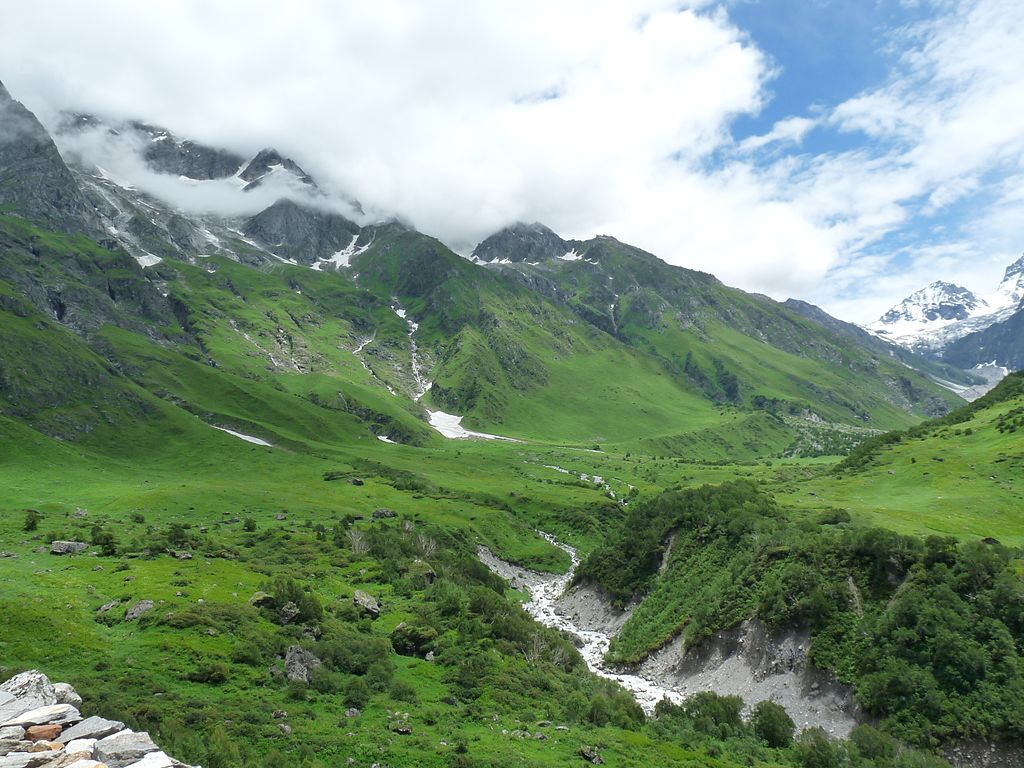
Your Unforgettable Himalayan Story Starts Now!
The Valley of Flowers trek package is more than just a place; it's an experience that stays with you long after you've left its vibrant paths. From the exciting trek to your cozy stays, the breathtaking blooms, and the peaceful moments at Hemkund Sahib, every part of this journey creates a story unique to you.
At TourMyHoliday, we're dedicated to making your adventure seamless, safe, and truly magical. We handle the details so you can focus on making incredible memories.
Are you ready to witness nature's finest masterpiece, breathe in the freshest mountain air, and discover the wonder of the Himalayas? Your unforgettable Valley of Flowers story is waiting to unfold.
Book your TourMyHoliday package today and step into a world of natural splendor!
Frequently Asked Questions:
1. What makes the Valley of Flowers so special compared to other trekking destinations?
The Valley of Flowers is renowned for its unmatched natural beauty, rich biodiversity, and serene environment. Unlike typical mountain treks, this alpine meadow bursts into a kaleidoscope of wildflowers every summer — home to over 600 species of flora, some of which are rare and endangered. It is also spiritually significant due to its proximity to Hemkund Sahib.
2. Is the Valley of Flowers suitable for first-time trekkers?
Yes. The trek from Ghangaria to the Valley of Flowers is considered moderate in difficulty, making it accessible even to beginners with average fitness. However, acclimatization to high altitude (around 3,600 meters) is important.
3. When is the best time to visit the Valley of Flowers?
The ideal time to visit is between mid-June and mid-October, when the flowers are in full bloom. July and August are peak months for vibrant colors, while September offers fewer crowds and cooler temperatures.
4. Are there any accommodations inside the Valley of Flowers?
There are no accommodations inside the valley itself. The nearest place to stay is Ghangaria, located about 3 km away. Ghangaria offers basic but clean guesthouses, eco-lodges, and dormitory-style stays managed by local authorities and private operators.
5. Do I need a permit to enter the Valley of Flowers?
Yes, all visitors require a permit to enter the Valley of Flowers National Park. These can be obtained at the entry gate in Ghangaria or arranged through your tour operator. Indian nationals and foreign tourists have separate entry fees.
6. How do I reach the Valley of Flowers from Delhi or Rishikesh?
From Delhi, you will drive to Govindghat / Pipalkoti via Haridwar and Karnaprayag (~280–300 km). From Rishikesh, the distance is similar. From there, it is a 14-km trek to Ghangaria, followed by a 3-km walk to the valley.
7. Is mobile network or internet available in the Valley of Flowers region?
Mobile network coverage is limited or non-existent once you leave Govindghat. In Ghangaria and parts of the trail, you may get BSNL connectivity, but other networks often don’t work. Internet access is not available.
8. Can couples or families visit the Valley of Flowers together?
Absolutely. The Valley of Flowers is a great destination for families, couples, and solo travelers alike. With proper planning and a moderate pace, even children and elderly members can enjoy the experience.
9. What kind of wildlife can I expect to see in the Valley of Flowers?
While large animals are rare due to high altitude, the area is rich in birdlife and small mammals. You might spot birds like the Himalayan Monal, Snow Pigeon, and various types of finches. If lucky, you might catch a glimpse of the elusive Blue Sheep (Bharal) in nearby areas.
10. Why is the Valley of Flowers a UNESCO World Heritage Site?
The Valley of Flowers National Park was declared a UNESCO World Heritage Site in 1988 due to its exceptional natural beauty, unique alpine flora, and ecological importance. It plays a crucial role in conserving high-altitude ecosystems and serves as a habitat for several rare and endangered species.
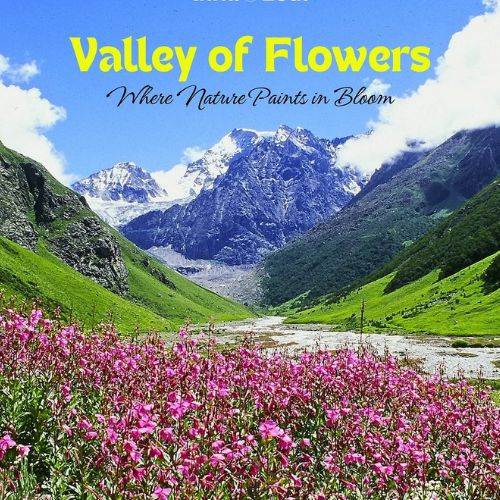

.jpg)
